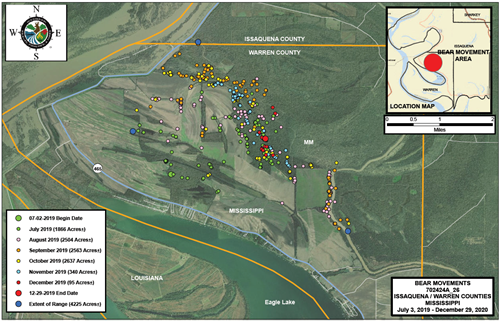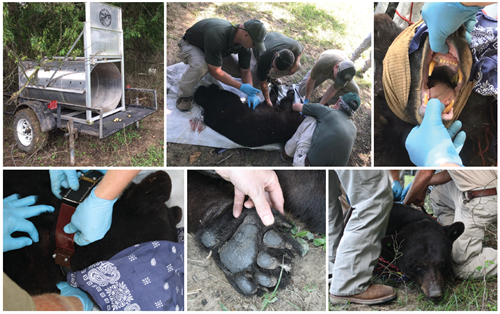Keeping up with the bears
4/6/2020 12:26:03 PM
By Jamie Holt, MDWFP black bear biologist

As many know too well, the South Delta region of Mississippi experienced flooding of historic proportions during the summer of 2019. More than 500,000 acres of land were inundated for months, and thousands of animals were displaced and congregated on any dry ground that could be found. One question came up regularly: What are the black bears doing during this flood?
It is no secret that black bears are adaptable, as well as proficient climbers. It is not uncommon for bears to escape to elevated dens in trees and wait out short-term flood events. But what about a flood that lasts for months? Simple reason tells us that a bear (or any animal capable of semi-arboreal residence) can only sit in a tree and chew on twigs for so long, right? Because the region had not experienced a comparable flood event since 1927, the Mississippi Department of Wildlife, Fisheries, and Parks (MDWFP) did not know precisely how black bears in Mississippi were handling the event.
South Delta
After receiving calls about bear sightings in the Eagle Lake area, MDWFP tried to capture as many bears as we could in the short amount of time we had before the flood-waters began to fall. We were successful in capturing three bears (one female and two males). All three bears were anesthetized, given a full health check, and fitted with a microchip identification tag and ear tags. To our surprise, all three bears seemed to be in good health and body condition, especially considering their current habitat.
We also fitted one of the males and the female with GPS tracking collars to monitor their movements once the floodwater receded. In the adjacent map (page 18), you can see a monthly representation of each bear’s progress in relation to the floodwater. Both bears followed the flood water almost immediately back into more suitable habitat. They expanded their respective home ranges back to typical sizes (in relation to males and females). Both bears will wear these collars for the next few years, giving us detailed information on their movements throughout the year.

North Delta
The northern part of the Delta did not experience quite the same degree of flooding outside of the Mississippi River levee. However, most of the known bears in these northern counties reside between the levee and the river in a unique stretch of land known as the batture, which most certainly saw the effects of the long-term flood event. On two different properties in Bolivar County, we had two female bears that each wore VHF, or radio-tracking, collars. These collars do not record the same GPS data as the newly fitted collars, but they do allow the bears to be located if we can get close enough.
“Close enough” became our most significant obstacle in determining where these bears had held up during the flood. We used an airplane fitted with receiver antennas affixed to the wings to cover as much ground as possible to find not only the bears but also assess the degree of flooding in their known home range. To our surprise, even with extensive flooding across most of the area, both bears were located within a short distance of their typical range with little to no dry land to be found.

Once these bears were located, our primary objective was to enter the areas as soon as the floodwaters fell. Any trapper will agree that outsmarting and catching a wild animal can be difficult, to say the least. Capturing a highly intelligent animal such as a bear can be especially difficult. But catching a specific bear, on an area with a high density of bears, can be downright daunting. Determination and perseverance eventually paid off, and both bears were captured and fitted with the new collars. Similar to their southern kin, overall health was remarkably well. Also like the bears in the South Delta, these females will be monitored over the next few years to assess their movements and hopefully offer us the opportunity to document the birth of cubs.
In summary, we know how adaptable bears can be to a wide variety of habitats, but this speaks to that adaptability on an entirely new level. We still do not know how these bears not only survived a flood event of this magnitude but also managed to maintain themselves so well in the process. Occurrences such as this are a reminder of how resilient black bears are. Most importantly, it reminds us as biologists that we must never become complacent in the pursuit of knowledge to help us better manage our diverse resources in Mississippi.









